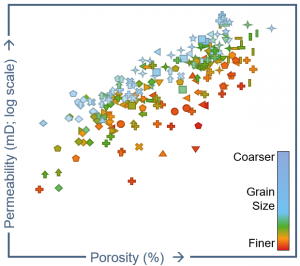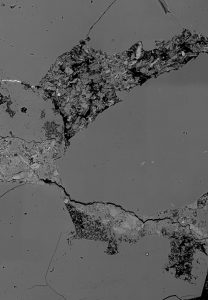Overview
![]() Petrography is used to assess the depositional character of samples of sandstone (and other sediment types). Sandstone texture strongly influences ultimate reservoir quality. Grain size and sorting not only govern the size of original intergranular porosity, but are also commonly linked to primary detrital mineralogy and subsequent diagenetic overprinting.
Petrography is used to assess the depositional character of samples of sandstone (and other sediment types). Sandstone texture strongly influences ultimate reservoir quality. Grain size and sorting not only govern the size of original intergranular porosity, but are also commonly linked to primary detrital mineralogy and subsequent diagenetic overprinting.
Characterisation and quantification of detrital components provides information on:
- variations in texture and mineralogy between different associated sedimentary facies
- changes in sediment composition (which may be driven by provenance and/or depositional settings) through and between sequences
- the probable availability of reactive components for diagenesis
- how the sediment is likely respond to burial and compaction
- fundamental sediment properties that ultimately control reservoir quality
Grain Size / Sorting Data (Textural Analysis)

Textural Analysis provides basic data about sandstone grain size and sorting characteristics. Grain size almost invariably exerts some control on final reservoir quality (either directly, or indirectly). The petrographic grain size data we collect is particularly useful when dealing with cemented or brecciated sands where original grain size may not be easy to determine during sedimentological core logging or by other bulk analytical methods such as seive or laser particle size analysis. More about Textural Analysis
Sedimentary Fabrics
Fine- and larger scale textures and heterogeneities within samples include features such as grain size lamination, variations in mineralogy (often linked to grain size), dewatering fabrics, slumping / soft sediment deformation fabrics and bioturbation. We also characterise the samples in terms of their overall tightness of packing (grain contact elongation, deformation of grains). This feeds into subsequent compaction analysis.
Detrital (Depositional) Mineralogies

Modal Analysis (A.K.A. “point count”) data provides fundamental information on sediment composition, including original detrital mineralogy, authigenic mineralogy and abundances of macroporosity. By looking at the present-day detrital components, and also the nature of dissolved / replaced components, we can often provide an indication of original (depositional) mineralogy.
There is usually a link between original mineralogy and final reservoir quality (e.g. sediments with high abundances of unstable lithic components may be prone to secondary porosity generation, but also clay mineral authigenesis; siliceous bioclasts are likely to be associated with microquartz cementation). More about Modal Analysis
Detailed characterisation of detrital components and their subseqent diagenetic overprinting is provided in our petrographic sample descriptions.
Provenance
By interrogating the textural and mineralogical data it is possible to differentiate between effects related to changes in grain size (i.e. depositional energy) and effects related to changes in sediment provenance.
